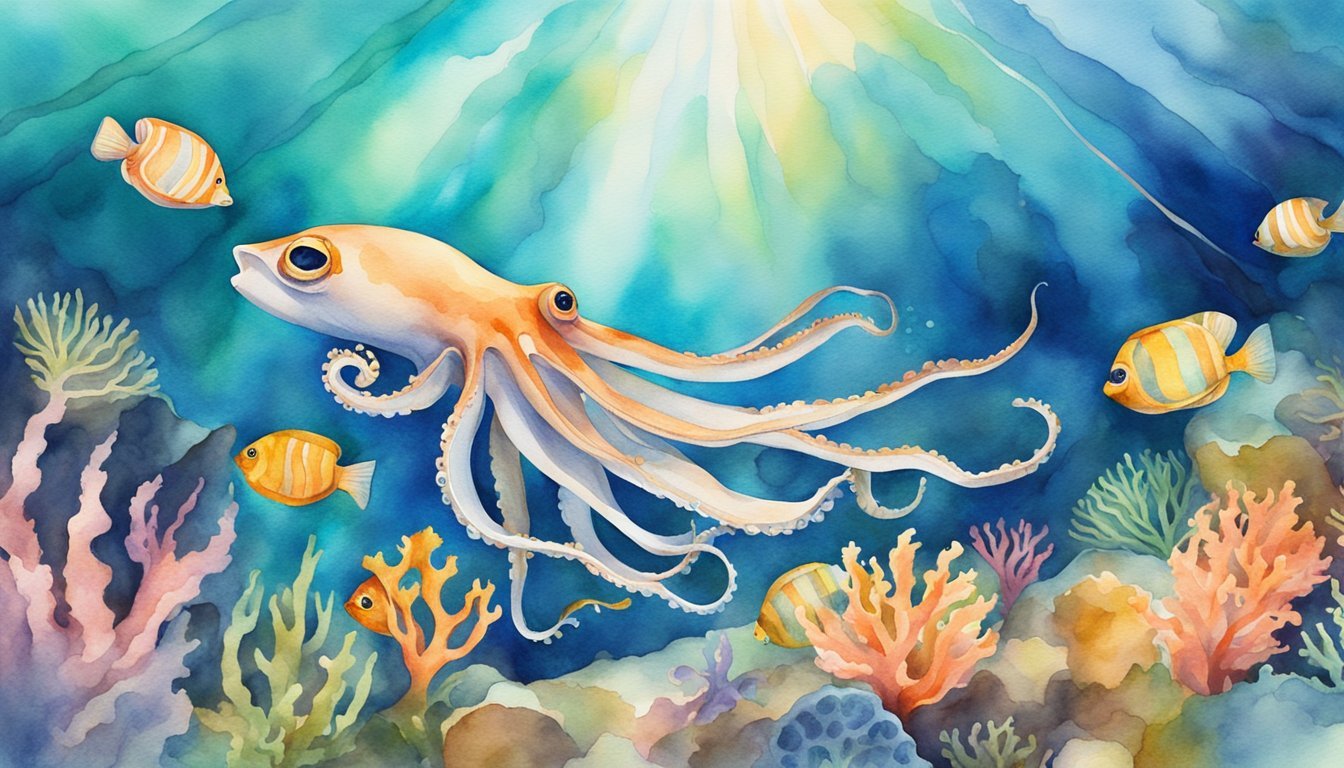Understanding Squid Biology
The fascinating world of squid encompasses a diverse array of species, each with unique anatomical features and adaptations for survival in the marine environment. These intelligent and mysterious creatures play a pivotal role in ocean ecosystems.
Anatomy and Physical Features
Squid are known for their distinctive body structure which includes a mantle, eight arms, and two longer tentacles. The mantle acts as a protective outer layer covering the main body, while the eight arms and two tentacles are equipped with suckers that assist in capturing prey. Squid can vary greatly in size and shape, with lengths ranging from a few centimeters in the case of the southern pygmy squid to monstrous proportions in the giant squid (Architeuthis spp.), which can exceed 13 meters. Most species have a form of an internal shell known as a gladius, which provides support. Their eyes are remarkably complex, rivaling those of many vertebrates, and some species, like the bigfin reef squid, display remarkable skin color changes and patterns for communication and camouflage. The beak of a squid is a formidable tool, used to slice through the prey’s tissue. Moreover, features like fins for navigation and bioluminescence for attracting prey or confusing predators are common.
Diversity in Species
With over 300 recognized species, squids exhibit a vast diversity. Species like the elusive colossal squid Mesonychoteuthis hamiltoni, which can weigh up to 495 kilograms, are at the larger end of the spectrum, while the previously mentioned southern pygmy squid, with its diminutive stature, represents the smaller varieties. This diversity is not just in size and weight but also in habitat preference, with species spread out across the world’s oceans, from the surface to the deep sea.
The Squid as a Cephalopod
Squid belong to the class Cephalopoda, a group of highly intelligent, mobile, and visually complex marine organisms. This class also includes octopuses, cuttlefish, and nautiluses. What sets squids apart from their cephalopod relatives is their streamlined bodies and faster mode of locomotion. They move through the water using a jet-propulsion system that involves expelling water from their mantle cavity. This adaptation is indicative of the incredible specialization cephalopods have undergone through their evolutionary history.
Squid in the Ecosystem

Squids are integral to marine biodiversity, playing crucial roles as both predators and prey. As adaptable cephalopods, they inhabit various parts of the oceans and influence many ecological relationships.
Habitats and Distribution
Squids are found in a wide range of oceanic environments, from surface waters to the deep sea. They have a remarkable ability to thrive in both coastal and open ocean conditions. Species such as the Caribbean reef squid are common in shallower areas while the elusive giant squids, like Architeuthis, prefer the dark depths of the ocean.
Diet and Predation
On the dietary spectrum, squids are carnivorous, feasting on a variety of organisms including fish, shrimp, and other invertebrates. Their hunting tactics are advanced, using jet propulsion for sudden bursts of speed, and their tentacles to snare prey. Squids themselves are a key prey item for predators such as sperm whales and are vital in the marine food web.
Reproduction and Lifecycle
The lifecycle of a squid is often characterized by fast growth and short lifespan, with a reproductive strategy known as semelparity, where they reproduce once before dying. The reproduction process involves the release of egg cases by the females and mate guarding by males in some species. Notably, some species, such as the Humboldt squid, grow rapidly, reaching impressive sizes in a brief time frame.
Squid and Human Interaction
Human interactions with squid are diverse, ranging from the importance of squid as seafood, known as calamari, to their role in scientific research due to their complex nervous system and advanced communication abilities via chromatophores. Overfishing and habitat destruction are the main human-induced threats to squids, necessitating considered management to safeguard their sustainability.

